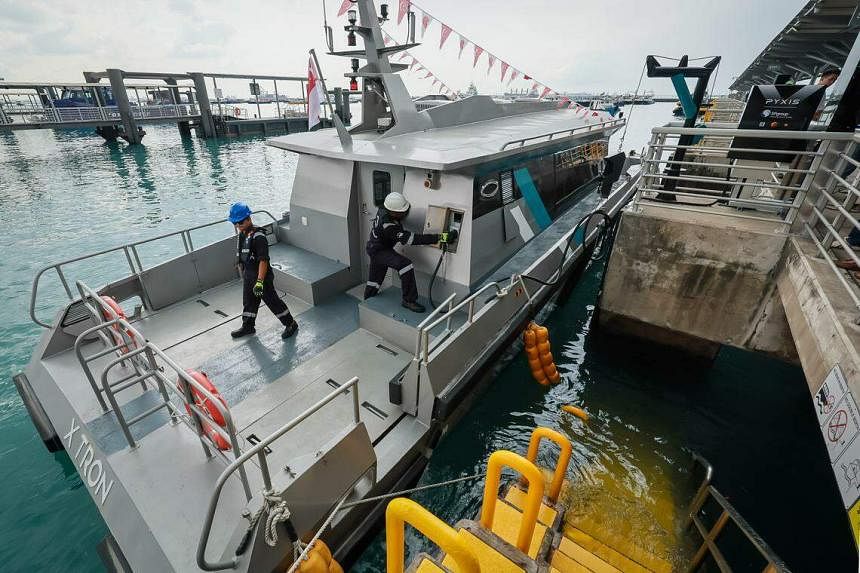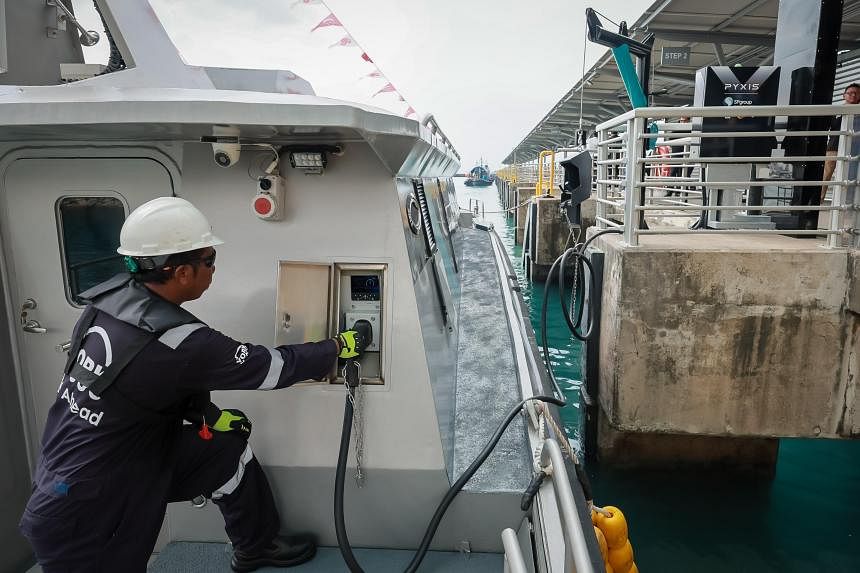SINGAPORE – A trial for the first public electric harbour craft charging point in Singapore began on April 8 at the Marina South Pier, as part of a two-year scheme to develop charging points across different locations.
Under the scheme, the Maritime and Port Authority of Singapore (MPA) will use the data collected from the trial to develop a national electric harbour craft charging infrastructure master plan, roll-out plans as well as national standards for such charging points.
Launched by Singapore maritime start-up Pyxis and SP Mobility, a subsidiary of national grid operator SP Group, the charging point at Marina South Pier features a 150 kilowatt (kW) direct current fast charger – similar to that of fast chargers for electric vehicles on land – and a cable management system that prevents the charging gun from dropping into the water.
Passenger vessel Pyxis X Tron – which is the start-up’s first fully electric passenger workboat for port and ship workers that debuted in March 2024 – will be used to test the charging infrastructure, and gather comprehensive data from its use.
The charger can charge an electric harbour craft – with a battery capacity of about 500 kilowatt-hour (kWh) – in around three hours and allow it to operate up to 50 nautical miles.
Many harbour craft are smaller vessels used to ferry workers and deliver goods from shore to ship, or between larger ships, within Singapore’s waters or anchorages.
For example, a full charge allows the Pyxis X Tron to complete four round trips between Marina South Pier and nearby anchorages that are more than 8km from the pier.
Other vessel operators may use the charging point too.
To operate it, users must lower the charging cable onto the vessel for a crew member aboard to connect it to the socket on the vessel.
Thereafter, they can scan a QR code on the charging point using the SP app and make payment to start charging the vessel.
In response to queries from The Straits Times on the charging costs, a spokesman for SP Group said the tariff for Marina South Pier would be similar to that for land-based chargers for electric cars, and that prices would be reviewed regularly to ensure that rates remain competitive.
Pyxis founder and chief executive Tommy Phun also said customers would be charged a per-kWh rate, based on the total amount of power transferred. He added that the tariff rates are still in the works but will be on a par with, or lower than, diesel options.
Speaking to reporters at the launch, Mr Phun said this test “marks a very good first step” in enabling the mass commercialisation of electric harbour craft.
He added that such electric harbour craft can raise efficiency because of per-use charging and the design of the vessel, compared with conventional vessels that run on diesel.

At present, six of about 1,600 harbour craft operating in Singapore waters are electric, said MPA.
Elsewhere, private electric harbour craft charging facilities are available on Pulau Bukom for electric ferries serving staff from energy company Shell.
When asked about the cost of setting up the charging point, Mr Phun said it is similar to that of a land-based charger for electric cars, with some add-ons including the cable management system for marine applications.
Separately, MPA is also working with trade agency Enterprise Singapore, the industry and academia to develop a technical reference – which includes safety, testing and inspection requirements – for an electric harbour craft charging and battery swop system. This would allow depleted batteries to be swopped out for fully charged ones in a short period.
A draft of the technical reference will be ready for public consultation by mid-April, noted MPA.
Captain M. Segar, MPA’s assistant chief executive of operations, said public-private partnerships are key to promoting the wider adoption of electric harbour craft in Singapore, including the improvement of vessel and battery designs as well as the building of charging infrastructure.
All new harbour craft in Singapore will need to be fully electric, capable of using pure biodiesel, or compatible with net-zero fuels such as hydrogen from 2030.

